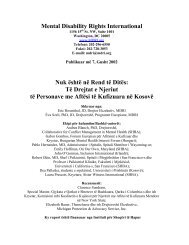Torture not Treatment - Disability Rights International
Torture not Treatment - Disability Rights International
Torture not Treatment - Disability Rights International
Create successful ePaper yourself
Turn your PDF publications into a flip-book with our unique Google optimized e-Paper software.
TORTURE NOT TREATMENT<br />
Laws on physical restraint violates Convention against <strong>Torture</strong><br />
Despite promising ―freedom from discomfort, distress, and deprivation which arise from an<br />
unresponsive and inhumane environment,‖ 175 the Massachusetts regulations designed to protect<br />
children with disabilities in any program funded by the Department of Developmental Services<br />
create gaping holes that leave children and adults at JRC without adequate protections. The use<br />
of physical restraints are inherently dangerous and create risk of severe emotional trauma –<br />
particularly for children. 176 Thus, it is widely understood that physical restraints should only be<br />
used as an emergency measure to protect against imminent harm. 177<br />
In contrast with the regulation of restraints for purposes of ―behavior modification,‖<br />
Massachusetts regulations create detailed procedural protections to limit the use of restraints in<br />
emergency situation where there is an imminent threat of self-injurious behavior, physical assault<br />
or other danger. 178 In addition, Massachusetts prohibits the use of ―continuous‖ physical or<br />
mechanical restraint beyond a 6 hour period 179 and ―non-continuous‖ restraint beyond 8 hours. 180<br />
The regulation has additional procedural safeguards in place when restraints are used on children<br />
(―any minor placed in mechanical restraint or physical restraint shall be examined within fifteen<br />
minutes….‖ 181 And restraints ―exceeding one hour in any 24 hour period‖ must be reviewed and<br />
reported to the Department of Developmental Services 182 ).<br />
Once at JRC, many students are restrained and kept isolated in a small room with one staff<br />
person, and ―inappropriate major behaviors‖ are documented until the school has amassed<br />
enough evidence to ask for court approval for the use of the electric shock.<br />
I was always in restraint when I came to JRC... Being in restraints wasn‟t helping me<br />
so I wanted GED…I had 20,813 problem behaviors in 5 months before the GED. –<br />
JRC video testimonial of student in support of GED, JRC website<br />
I was kept in a small room, isolated. One staff and me for a year and a half. – JRC<br />
video testimonial in support of GED, JRC website<br />
I was in restraints constantly…I was in an isolated room. Then I went on the GED<br />
– JRC video testimonial in support of GED, JRC website<br />
In theory, even with all these protections, the regulation on emergency restraints would be<br />
subject to tremendous abuse. In practice, the regulation permitting emergency restraints does <strong>not</strong><br />
speak to the use of restraints for eight hours day after day. The pain and suffering that can be<br />
caused by a lifetime of eight hour days in restraints is almost limitless.<br />
Yet Massachusetts does <strong>not</strong> include these limited protections for children or adults subject to a<br />
―behavior plan.‖ Any use of restraints as part of an approved behavior modification plan, is<br />
32




